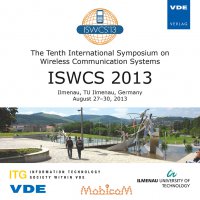Real Interference Alignment with Opportunistic Scheduling
Conference: ISWCS 2013 - The Tenth International Symposium on Wireless Communication Systems
08/27/2013 - 08/30/2013 at Ilmenau, Deutschland
Proceedings: ISWCS 2013
Pages: 5Language: englishTyp: PDF
Personal VDE Members are entitled to a 10% discount on this title
Authors:
Kuchi, Kiran (Indian Institute of Technology Hyderabad, India)
Abstract:
This paper considers a system with K = 3 single antenna transmitters each serving L single antenna users. We propose two techniques that offer high network capacity. In the first proposed method, all transmitters synchronously send realvalued data symbols while each user reports the post-processing signal-to-interference-plus-noise-ratio (SINR) of a widely linear minimum-mean-square-estimation (WL MMSE) receiver to its own transmitter. Each transmitter schedules a user with maximum reported SINR. We show that a user is typically scheduled when the real-valued interference channels vectors tend to align to a common direction. This phenomenon is referred to as real spatial interference alignment (SIA). An expression for outage capacity as a function of number of users is derived. We show that in a symmetric interference channel (SIC), the number of active users required to achieve certain target outage capacity grows as square root of signal-to-noise-power-ratio (SNR). In the low-to-medium SNR regime, real SIA helps the system to attain a high sum capacity with a moderate number of users. In the second proposed method, we propose an encoding method that exploits explicit IA along with real SIA. Considering three users associated with three transmitters, we apply explicit interference alignment (IA) for any two of the three users served by their respective transmitters using channel state feedback. For the third user, we rely on real SIA obtained via opportunistic scheduling for interference mitigation. This technique requires significantly reduced number of users to achieve near interference free capacity.


